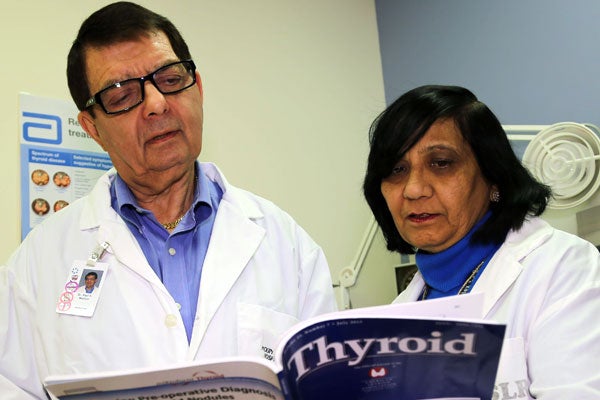
Personalized medicine: new biomarker for oral cancer
Published: November 12, 2013
University of Toronto researchers have identified a protein that can help doctors predict whether a patient will develop oral cancer – one of the most common cancers in Asia.
Paul Walfish of the department of medicine and Ranju Ralhan of the department of otolaryngology - head and neck surgery say the protein acts as a biomarker that can help determine whether an oral lesion is likely to become malignant.
Some cancers develop quickly and are aggressive, while others develop slowly and are easily managed. Biomarkers are used to help predict how a particular patient's cancer will behave and what treatment options would work best for that patient.
Genomics, which focuses on a cell’s DNA, has been a popular method for identifying biomarkers. But Walfish and Ralhan used proteomics, which identifies specific cellular proteins.
"Proteins are really the workhorses of cells,” Ralhan says. “If you focus your attention on their expression and function, you can quickly obtain an understanding of relevant biomarkers.”
Using this approach has led to identification of the S100A7 protein as a predictive biomarker for an oral lesion with dysplasia (abnormal cells) called a premalignant lesion. These types of lesions can lead to cancer. However, it’s difficult to predict which of these oral lesions will become cancerous and how rapidly. Identifying the patients who would benefit from early intervention is a major clinical challenge.
“We are extremely pleased to have identified a protein which can predict which oral dysplastic lesions will transform. This will be a great tool to find out which patients really need closer follow-up, and in time this will lead to better patient survival,” says Walfish, who is director of the Mount Sinai Hospital’s Alex and Simona Shnaider Research Laboratory in Molecular Oncology.
“The overexpression of S100A7 can demonstrate the aggressiveness of the premalignant lesion, which can help doctors determine the best course of treatment,” says Ralhan, who is the co-director of the Shnaider Laboratory and Canadian Institute of Health Research Chair in Advanced Cancer Diagnostics.
Treatment for advanced oral cancer can cause severe pain, disfigurement and poor quality of life in survivors, says Ralhan. Being able to accurately predict whether treatment is needed spares the patient unnecessary discomfort by avoiding overtreatment and providing greater cost savings.
Oral cancer is particularly common in India and China — where smoking or chewing tobacco and betel quid are common — but incidents are also increasing in North America.
Their findings, detailed in the international Journal of Cancer, have been independently verified by labs in both Toronto and New Delhi. (See the journal online.)
Working with an interdisciplinary team of researchers that includes pathologists, oncologists and surgeons, Walfish and Ralhan are continuing to explore how protein biomarkers can help diagnosis and prognosis of other epithelial cancers. For example, they have also used their approach to identify biomarkers for types of breast and thyroid cancer.
“Since there is a lot of interest in personalized medicine, biomarkers identified by proteomics offer a more feasible option,” says Walfish.
Liam Mitchell is a writer with the Faculty of Medicine at the University of Toronto.



